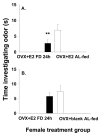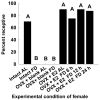Food deprivation and the role of estradiol in mediating sexual behaviors in meadow voles
- PMID: 17112551
- PMCID: PMC1855151
- DOI: 10.1016/j.physbeh.2006.09.034
Food deprivation and the role of estradiol in mediating sexual behaviors in meadow voles
Abstract
Female mammals are particularly sensitive to changes in food availability. The mechanisms that affect sexual behavior and food intake are closely related to one another; chief among the mechanisms that control sexual behaviors in females is estradiol. In order to understand how food deprivation results in inhibition of sexual behavior (attractivity, proceptivity, and receptivity), we measured the effects of food deprivation on circulating concentrations of estradiol. We also determined whether estradiol treatment was sufficient to restore sexual behaviors in food-deprived female meadow voles. We found that estradiol titers of food-deprived female voles are significantly lower than those of ad lib-fed female voles. Further, we found that estradiol treatment was sufficient to restore proceptivity and receptivity in food-deprived, ovariectomized female voles. However, estradiol treatment was not able to overcome the food deprivation-induced inhibition of attractivity. Thus, decreases in estradiol titer of food-deprived female voles may be related to the suppression of their proceptive and receptive behaviors, and may be a mechanism that allows females to avoid mating when conditions are not propitious for their survival and that of their offspring.
Figures






Similar articles
-
Re-feeding and the restoration of odor attractivity, odor preference, and sexual receptivity in food-deprived female meadow voles.Physiol Behav. 2005 Mar 31;84(4):553-61. doi: 10.1016/j.physbeh.2005.02.003. Physiol Behav. 2005. PMID: 15811390
-
Effects of food availability on proceptivity: a test of the reproduction at all costs and metabolic fuels hypotheses.Behav Processes. 2012 Oct;91(2):192-7. doi: 10.1016/j.beproc.2012.07.008. Epub 2012 Aug 3. Behav Processes. 2012. PMID: 22884977
-
The Effects of Food Availability on the Sexual Behavior of Meadow Voles.Integr Comp Biol. 2017 Dec 1;57(6):1240-1244. doi: 10.1093/icb/icx025. Integr Comp Biol. 2017. PMID: 28992105 Review.
-
Food deprivation inhibits estrous behavior in hormone-treated Syrian hamsters despite elevated estradiol levels.Horm Behav. 2002 May;41(3):316-20. doi: 10.1006/hbeh.2002.1764. Horm Behav. 2002. PMID: 11971665
-
Exogenous melatonin administration affects self-grooming and conspecific odor preferences in long-photoperiod meadow voles (Microtus pennsylvanicus).Physiol Behav. 2007 Jun 8;91(2-3):255-63. doi: 10.1016/j.physbeh.2007.03.010. Epub 2007 Mar 16. Physiol Behav. 2007. PMID: 17449071 Free PMC article.
Cited by
-
The dynamics of health in wild field vole populations: a haematological perspective.J Anim Ecol. 2008 Sep;77(5):984-97. doi: 10.1111/j.1365-2656.2008.01413.x. Epub 2008 Jun 28. J Anim Ecol. 2008. PMID: 18564292 Free PMC article.
-
Insulin signalling regulates remating in female Drosophila.Proc Biol Sci. 2011 Feb 7;278(1704):424-31. doi: 10.1098/rspb.2010.1390. Epub 2010 Aug 25. Proc Biol Sci. 2011. PMID: 20739318 Free PMC article.
-
Self discrimination in meadow voles, Microtus pennsylvanicus.Ethology. 2008 Sep;114(9):10.1111/j.1439-0310.2008.01531.x. doi: 10.1111/j.1439-0310.2008.01531.x. Ethology. 2008. PMID: 24415819 Free PMC article.
-
Insulin Signaling in the Peripheral and Central Nervous System Regulates Female Sexual Receptivity during Starvation in Drosophila.Front Physiol. 2017 Sep 8;8:685. doi: 10.3389/fphys.2017.00685. eCollection 2017. Front Physiol. 2017. PMID: 28943854 Free PMC article.
-
Gonadal hormones modulate sex differences in judgments of relative numerousness in meadow voles, Microtus pennsylvanicus.Horm Behav. 2009 Jan;55(1):76-83. doi: 10.1016/j.yhbeh.2008.08.010. Epub 2008 Sep 10. Horm Behav. 2009. PMID: 18809407 Free PMC article.
References
-
- Bronson FH. Mammalian Reproductive Biology. University of Chicago Press; 1989. pp. 47–185.
-
- Seymour PL, et al. Corticotropin-releasing factor receptor subtypes mediating nutritional suppression of estrous behavior in Syrian hamsters. American Journal of Physiology. 2005;289:R418–R423. - PubMed
-
- Wade GN, Jones JE. Neuroendocrinology of nutritional infertility. American Journal of Physiology. 2004;287:R1277–R1296. - PubMed
-
- Wade GN, et al. Control of fertility by metabolic cues. American Journal of Physiology. 1996;270:E1–E19. - PubMed
-
- Jones JE, et al. Disinhibition of female sexual behavior by a CRH receptor antagonist in Syrian hamsters. Am J Physiol. 2002;283:R591–R597. - PubMed
Publication types
MeSH terms
Substances
Grants and funding
LinkOut - more resources
Full Text Sources

